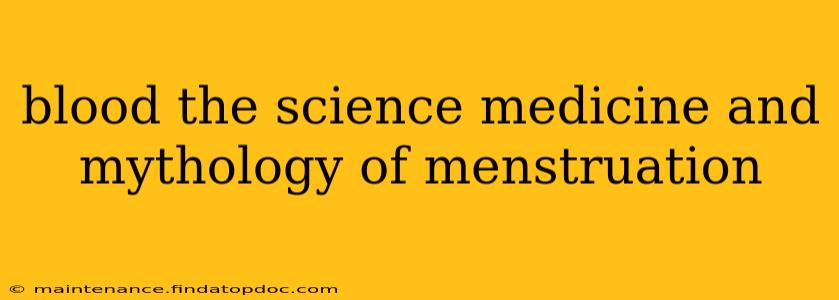Menstruation, a biological process unique to women, has been shrouded in mystery, myth, and even taboo for centuries. While modern science has unveiled the intricate biological mechanisms behind menstruation, its cultural and historical significance continues to resonate. This comprehensive exploration delves into the science, medicine, and mythology of menstruation, providing a holistic understanding of this vital aspect of female biology.
What is Menstruation?
Menstruation, commonly known as a period, is the monthly shedding of the uterine lining (endometrium). This lining thickens each month in preparation for a potential pregnancy. If pregnancy doesn't occur, the lining breaks down and is expelled from the body through the vagina as menstrual blood. This cycle, typically lasting around 28 days, is regulated by complex hormonal interactions involving estrogen and progesterone. The process is a natural and healthy part of a woman's reproductive life, typically starting during puberty (menarche) and ceasing with menopause.
What are the Physical Changes During Menstruation?
The physical changes experienced during menstruation vary from woman to woman, but common symptoms include:
- Cramping: Caused by uterine contractions as the lining sheds.
- Bleeding: The amount and duration of bleeding can vary, with some women experiencing heavier flow than others.
- Mood swings: Hormonal fluctuations can affect mood, energy levels, and emotions.
- Breast tenderness: Hormonal changes can lead to breast sensitivity or swelling.
- Bloating: Fluid retention is common.
- Fatigue: Some women experience tiredness and lethargy.
What are the Medical Aspects of Menstruation?
While menstruation is a natural process, various medical concerns can arise:
- Dysmenorrhea: Painful periods, often caused by uterine cramps.
- Amenorrhea: Absence of menstruation, which can be caused by various factors including hormonal imbalances, stress, or certain medical conditions.
- Menorrhagia: Heavy or prolonged bleeding, which can lead to anemia.
- Premenstrual Syndrome (PMS): A range of physical and emotional symptoms experienced in the days leading up to menstruation.
- Premenstrual Dysphoric Disorder (PMDD): A severe form of PMS with significant emotional and physical symptoms that interfere with daily life.
Seeking medical advice is crucial if you experience excessively painful periods, irregular bleeding, or other concerning symptoms. Effective treatments are available for various menstrual disorders.
How is Menstruation Viewed Across Cultures and Throughout History?
The cultural perceptions of menstruation have varied significantly across different societies and throughout history. In some cultures, menstruation has been viewed as a sacred or powerful time, associated with fertility and creativity. In others, it has been stigmatized and linked to impurity or negativity, leading to social exclusion and restrictions on women's activities during their periods. These varied perspectives reflect the complex interplay between biology, culture, and societal norms.
What are Some Myths and Misconceptions Surrounding Menstruation?
Many myths and misconceptions surrounding menstruation persist. Some common ones include:
- You can't exercise during your period: Moderate exercise is generally beneficial and can even alleviate cramps.
- You can't swim during your period: With a tampon or menstrual cup, swimming is perfectly safe.
- Menstruation is a sign of weakness: Menstruation is a natural and healthy process, not a sign of weakness.
- Certain foods make periods worse: While some foods might exacerbate PMS symptoms, there's no scientific evidence linking specific foods to heavier bleeding or more painful cramps.
How Can I Manage Menstrual Symptoms?
Managing menstrual symptoms effectively often involves a combination of lifestyle changes and, in some cases, medical intervention. Strategies include:
- Regular Exercise: Physical activity can help reduce cramping and improve mood.
- Healthy Diet: A balanced diet rich in fruits, vegetables, and whole grains can support overall health and well-being.
- Stress Management Techniques: Stress can exacerbate menstrual symptoms, so relaxation techniques like yoga or meditation can be beneficial.
- Over-the-counter Pain Relief: Medications like ibuprofen or naproxen can help alleviate cramps.
- Heat Therapy: Applying heat to the lower abdomen can soothe cramps.
What are Menstrual Products and Which One is Right for Me?
Several menstrual products are available, including:
- Pads: Absorbent pads worn externally.
- Tampons: Absorbent tampons inserted into the vagina.
- Menstrual Cups: Reusable cups that collect menstrual blood.
- Menstrual Discs: Similar to cups but flatter and wider.
- Period Underwear: Underwear with an absorbent lining.
The best product for you depends on personal preference, flow, and lifestyle.
This exploration aims to provide a comprehensive overview of menstruation, encompassing its scientific basis, medical implications, and cultural significance. By dispelling myths and misconceptions, we hope to promote a better understanding and acceptance of this fundamental aspect of female biology. Remember, if you have any concerns about your menstrual health, consult a healthcare professional.
